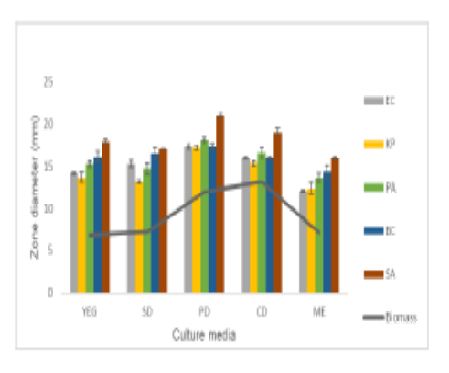


Indian Journal of Science and Technology
DOI: 10.17485/IJST/v16i22.1027
Year: 2023, Volume: 16, Issue: 22, Pages: 1614-1623
Original Article
Nidhi S Trivedi1, Jignasha Thumar2,*
1Department of Microbiology and Biotechnology, School of Sciences, Gujarat University, Ahmedabad, Gujarat, India
2Department of Microbiology, Government Science College, Sector15, Gandhinagar, Gujarat, India
*Corresponding Author
Email: [email protected]
Received Date:02 May 2023, Accepted Date:19 May 2023, Published Date:03 June 2023
Objectives: The purpose of this study was to investigate the antibacterial properties of an endophytic fungus, Aspergillus sp., isolated from the roots of the Avicennia marina belonging to an unexplored location in Kutch, Gujarat, India. The study aimed to optimize various factors to enhance the production of antimicrobial compounds. Methodology: Antimicrobial activity was performed using the agar-well diffusion method, and the results were compared with the standard antibiotic streptomycin as a positive control and DMSO as a negative control. The classical one-factor-at-a-time (OFT) approach was used to optimize various factors such as temperature, pH, culture media, carbon and nitrogen sources, and solvents to enhance antimicrobial production. Response Surface Methodology (RSM) was used to statistically optimize the production of antimicrobial compounds. Findings: The investigation revealed that the endophyte exhibited remarkable inhibitory action against sensitive strains of Klebsiella pneumoniae, Escherichia coli, Pseudomonas aeruginosa, Bacillus cereus, and Staphylococcus aureus. The most suitable conditions for the production of antimicrobials were; an inoculum size of 1*105 in potato dextrose medium at a temperature of 25◦C and pH 6, with an incubation period of 12 days. Starch and ammonium chloride acted as the best carbon and nitrogen sources, respectively. The use of RSM resulted in a 1.46-fold increase in the antimicrobial activity against Pseudomonas sp., with an increase in the zone of inhibition from 18.36mm to 26.8mm. Novelty: The study highlights the unique antimicrobial potential of an unexplored endophyte derived from Avicennia marina roots in Kutch, Gujarat, India. RSM played a crucial role in detecting optimum conditions for the production of antimicrobial compounds, resulting in a significant increase in activity. Its application emphasizes the importance of advanced statistical techniques in improving our understanding of complex biological systems.
Keywords: Avicennia marina; Antimicrobial; Box-Behnken design; EndophyticFungi; Mangroves
© 2023 Trivedi & Thumar. This is an open-access article distributed under the terms of the Creative Commons Attribution License, which permits unrestricted use, distribution, and reproduction in any medium, provided the original author and source are credited. Published By Indian Society for Education and Environment (iSee)
Subscribe now for latest articles and news.